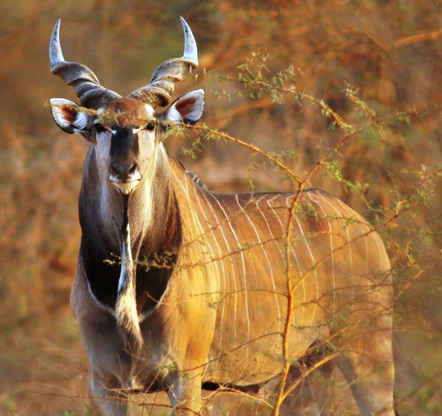Facts About Giant eland
Meet the giant eland, also known as the Lord Derby eland, a majestic antelope that inhabits the open forests and savannas of Africa. Belonging to the Bovidae family and Taurotragus genus, this species holds the title of the largest antelope, with a body length ranging from 220 to 290 cm. First described in 1847 by John Edward Gray, the giant eland is a herbivore, feeding on grasses, foliage, and branches.
These magnificent creatures typically form small herds consisting of 15 to 25 members, including both males and females. Unlike some animals, giant elands are not territorial and are known for their incredible speed, capable of sprinting up to 70 km/h to evade predators. Their mating season peaks during the wet season, although breeding can occur year-round. You can often find them in broad-leafed savannas, woodlands, and glades.
Native to several African countries, the giant eland faces significant conservation challenges due to overhunting and habitat loss. There are two subspecies: T. d. derbianus and T. d. gigas, each with different conservation statuses according to the IUCN. The scientific name, Taurotragus derbianus, honors Lord Derby, who introduced the species to England in the 19th century. The name combines Greek words meaning "bull" and "male goat" with a nod to Lord Derby.
Giant elands are spiral-horned antelopes, with males being larger than females, weighing anywhere from 400 to 1,000 kg. They sport a reddish-brown coat adorned with white stripes and have distinctive features such as a crest of black hair, long legs, and spiral horns. Adaptable to various habitats, including savannas, woodlands, and even deserts, these antelopes are primarily nocturnal and sociable, often seen in groups.
When it comes to reproduction, giant elands can breed year-round. Females reach sexual maturity at two years old, while males mature at four to five years. They have a nine-month gestation period, and calves stay close to their mothers for about six months. Unfortunately, they face threats from overhunting, habitat destruction, and competition with domestic animals. Conservation efforts are in place, including habitat protection in national parks and reserves, as well as breeding programs in captivity.
Giant elands are prized for their meat, hides, and milk, which is richer in proteins and fat than cow's milk. They are also hunted for trophies and domesticated in some regions due to their resilience to harsh conditions. Their ability to thrive on minimal water and coarse grasses makes them a valuable asset in certain areas.

 Central African Republic
Central African Republic